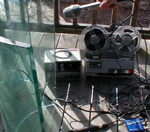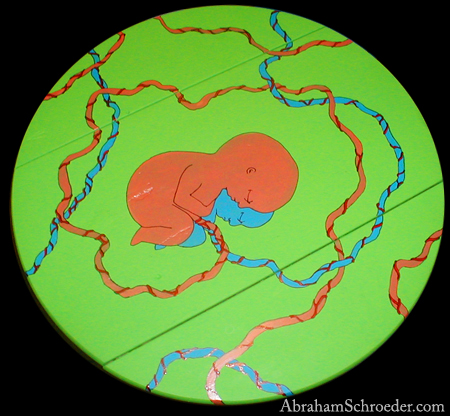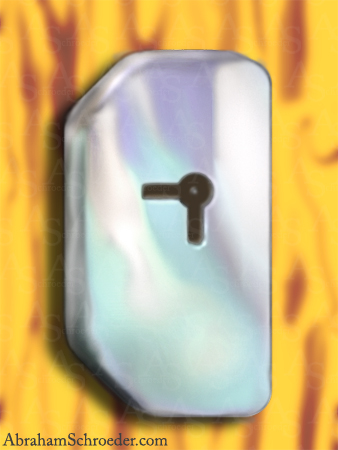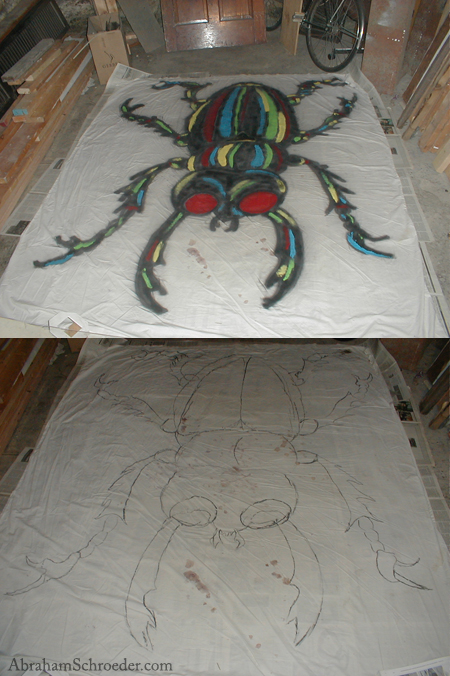Miscellaneous Work
Much of my work doesn't fall in clear categories. Here are some random sketches and other images, plus an article originally published in 2004 about an audio project. (Image and audio files are not yet linked to the article.
Use the slider to scroll right or left in the gallery. Final printed images do not contain watermarks.
Misc
|
|
Article
|

Text and photographs by Abraham Schroeder The artist's initial inspiration came from a 1983 article by Joseph Margolis, who introduces the idea of a symphony performance recreated from spliced sounds. [1] "At first when I read this I was blown away, I mean the implications are wild. And then I thought, 'Hey, I could do that! What a crazy challenge.'" In the book containing the Margolis article is a reprint of a 1976 article by Mark Sagoff that discusses the difference between the song of a nightingale providing a sweet serenade to a party and a clever boy in the bushes imitating the sound of a nightingale. Initially they are indistinguishable but once the difference is revealed, the boy no longer inspires the same quiet admiration in the party guests. [2] "I got to thinking about what sounds sound alike, what is sound, what do we hear, what is recording, what is listening? It's really heavy when you get into it. The art of mimicry goes way back on an evolutionary scale. Visual and auditory camouflage have always been a part of survival. The only difference now is that we have the technology to achieve a precision and complexity never before imaginable." An experience the artist had while traveling in Europe solidified his conviction to undertake such a massive task. "I was on the train between Vienna and Budapest, enjoying the ride, everything's normal, and then all of a sudden I heard this sound. I don't know if was the brakes or what, but it jolted me out of whatever I was thinking about. It was this high-pitched whine that lasted about a second, and as soon as it stopped I got this sort of empty beat. That fall-forward feeling of anticipation that was best described to me once by an Afro-Cuban drummer talking about the Rumba. Anyway, the sound I heard was almost exactly the same as the intro to Marilyn Manson's Beautiful People. It was uncanny. And it kept happening. I must have heard that sound two-dozen times on the train ride and every time I expected the song to start. It's one thing to groove along to a funky train beat, but quite another thing to mistake a train for a guitar. When I got home I grabbed a tape recorder and mic and started recording." Six years and many sleepless nights later, the project is finally pieced together. Page 2 "It's basically audio collage. You've probably seen those paintings from the 1500's of what's his name, Guiseppe Arcimboldo, who painted portraits, but made out of fruits and vegetables. There were also some Japanese paintings and prints by Kuniyoshi and others, heads made out of bodies, a cat made out of cats. I've always loved collage. There's something magical about taking a shape or gesture out of one context and putting into another to create an entirely new set of circumstances that still retain reference to the original." With the technology he developed now in place, he says the project could be done again entirely on the computer, and in fact he has recently started work on a second song, but when he began six years ago he found reel-to-reel audiotape was preferable for a number of reasons. "At the time the computers weren't fast enough, the cost was prohibitive, and of the audio software available, nothing was quite right for what I was doing. I used a lot of tape when I worked in radio a bunch of years back, and I have always loved the tactile experience of working with it. I like using my hands and I think better in real space than in a digital one." He found that the properties of tape made it a very effective medium that allowed for flexibility and precision. But despite the advantages, in the end it was the power and speed of computers that led to the reworking and eventual completion of the project. "The cutting and splicing can be done in a variety of ways, and the tape can be stretched and altered, re-dubbed and played back with near infinite flexibility. It was only in the third year that I upgraded to mostly a computer-based system. I basically had to start over, but it was much faster because I already had a ton of footage, I really understood the way everything had to come together, and so I started building the software that would feed off the database. Moving away from just tape was also necessary because the human ear is far from perfect and I had to compare the two sound waves and adjust minute timings and slight pitch shifts. The tape is also subject to degradation and stretching, and I was ready to up the level of perfection." One of the first steps in the incredibly long process was to pick a song. "It had to be good because I knew I would be listening to it a lot. I picked One because of its complexity. Metallica's sound ranges from soft and sweet classical guitar riffs to hard, grinding, rhythm metal with heavy drum work. My first impulse was to do something purely classical like in [Margolis'] article, but in the end I decided a more contemporary sound would keep me and potential audiences more interested. It's also a tricky song and I wanted to flex my splicing chops a bit. It's only been recently, with all the news stories about copyright infringement and digital file-sharing that I realized what an important choice the song was." The next step after picking the song was to start listening, very carefully, to the whole song, to phrases, to notes, partial notes, and the subtle overlaps among the parts. "I listened to that song probably two hundred-thousand times, and I worked the pause button so hard I went through a couple of CD players. In the beginning I made lots of copies on reel that I could get my hands into, cutting, flipping around. I was really into the physical part of it and really interested in manipulating sounds, twisting them, molding them, like brush strokes or clay." Page 3 Initially he had planned to do all of the filtration and manipulation manually, using a variety of homemade contraptions to alter the sounds he gathered from the world. The process was streamlined a lot when he moved to the computer but in the beginning it was, as he describes it, "like a mad scientist gone mad." "I had a bunch of crazy rigs set up all over my house and backyard - tin cans, bowls of water, plastic tubes, springs, rocks, you name it - and I had to figure out how to find, create, or change the sounds I had to fit the song." "It's all about impulse and inspiration. You have to feel the music and think, ' What does that remind me of?' His voice sounds like a frog here, that guitar sounds like a train crash, the other guitar sounds like an owl, only higher and sort of glassy. So you get the first impulse and then you have to do the work. It's like, okay, what kind of frog, what kind of train, what kind of owl, what kind of glassy, and then you have to go out and find those sounds or make them. Like I might take an owl sound and play it into a crystal bowl, but then realize that I can get the whole sound by just rubbing my finger inside the bowl, but maybe it needs something else like I have to put some grit in it and since I'm in the kitchen I grab the Cheerios, but the box falls on the floor and the bag crinkles and that mess sounds like some other part of the song so I get sidetracked dropping cereal boxes for two hours before I even get back to the owl guitar. You can see it starts to get out of control pretty quickly." Building the database and software proved to be an enormous undertaking as well, but it greatly accelerated the process. "The idea is simple: you get a lot of sounds, put them in a searchable database, let the computer match the waves of the stock footage to the original, and then sequence the lot. Actually doing it - not so easy." By the time he finished the project, his sound bank held close to a billion audio samples, and his software had evolved into a complex patchwork of commercial audio editing programs, voice-recognition technology, and office database software, pieced together with lines of new programming written to address and tackle specific needs and problems that inevitably arose over the course of the project. "It was a huge learning process, a lot of trial and error, but when I sorted it all out, it came together surprisingly well. I couldn't have done it without all my computer science friends who were patient enough to walk me through some of the basics and not-so-basics." A billion audio samples may sound like a lot but he had to choose sounds carefully to minimize the time and space needed to complete the project. Every extraneous recording takes up as much space as a useful one, and increases strain on the computer's operating speed. He also felt strongly about gathering sounds, rather than generating them. Page 4 "I wanted to be as authentic as possible. What I mean by that is that I did not want to synthesize the sounds. Any fool can take a synthesizer and tweak a few knobs it until it sounds like a guitar. I wanted to find sounds in the world and bend them just slightly to fit. It's one thing to adjust a sine wave until it sounds like a high hat, but a very different thing to bang a spoon on a piece of aluminum foil with rice wrapped inside to produce the same sound. I learned a ton about the structure of sound, just by listening and doing. I got a feel for how different kinds of waves behaved under various circumstances. Play the sound of a digging mole into a six-inch plastic pipe or a twelve-inch metal pipe and see how different it sounds. I had daily, and sometimes hourly surprises, for instance, one morning I found that if you invert the song of a sparrow, it sounds remarkably like a classical cello performance. [see Fig. 4] Too bad I didn't need a cello." The process has not been entirely straightforward, and has generated a whirlwind of controversy that will probably not end any time soon. The legal battle is going strong, and with recent press coverage, the public debate is just as heated. "About a year ago some magazine heard about what I was doing and they sent a reporter over. I played the guy a sample and answered his questions. Then he called the record company to get an opinion or something and somebody or another decided what I was doing was not cool. At that point there was no way I was stopping, not after I all those years of hard work. I didn't - don't - think what I was doing was illegal, or even close to it, though I could see why it might make the big boys nervous. I thought it was a noble cause, or at least a really cool art project, so I braced myself for the s__t to hit the fan, which it eventually did, though not for some time." At issue are questions of copyright infringement, piracy, and even forgery. Though the artist cannot discuss the case in detail, and it is unclear what specific charges, if any, have been filed, what is clear is that modern technology daily challenges legal standards and intellectual property laws. The past few decades brought the evolution of musical genres like Hip-Hop, Rap, and Techno, which have created heated controversy over audio sampling, artistic license, and fair use. Recent scandals involving Napster and internet file sharing, and the Beatles/Jay-z hybrid "The Grey Album," have further thickened the controversy, and this new case is already bringing to light new implications and complications. "It's funny, that [Margolis] article talked about [Jorge Luis] Borges', ' Pierre Menard, Author of Don Quixote,' a fictional story in which a writer recreates, word for word, Cervantes' famous work. His version may look like a simple transcription but is in fact a loving ode to the original. I went right out and bought a copy of that story, and the same issues definitely apply to this case. The only difference is that Borges was writing fiction, a hypothetical case to prove a point, whereas this is the real deal so it's touchier and more complicated." Critics say that the artist has produced a forgery or a straightforward copy, albeit through unconventional means. Some say it shows a lack of originality, that he had is just copying successful artists because he lacks the creativity necessary to make his own work, or worse, some people do not believe that he actually did what he says he did. They say he is just selling a copy as his own work, and this is a scam. Others say this is the first step toward a fresh attack on copyright laws. "I didn't copy the song, and I didn't spend the last six years doing what I could have done in five minutes. I remade the song to an exacting likeness, but using an entirely different set of instruments than the guitars, drums, and voices that Metallica used. The finished product might sound exactly the same but it is in fact my humble ode to the genius that produced the original work. Metallica rocks. I don't want to rip them off. But as soon as you get into issues of authenticity, reproduction, forgery, and imitation, especially the grey areas, you really start messing with people's emotions and belief systems." Page 5 Neither Metallica nor their record company could be reached for comment on the case before the publish date of this article. The artist says he is inspired by Chinese and Japanese artistic traditions in which paintings by masters are copied and reinterpreted by later generations. Though the same composition may be used hundreds of times by as many artists, it is not (usually) for deception or monetary gain that these works are copied, but as a means for less experienced artists to get closer to, and experience some of the essence of the old masters, much in the way that in the western traditions, students may produce a study of a Rembrandt or van Gogh to learn about techniques specific to that artist's work. "I read an article back in college about a concept called intertextuality. I don't remember who wrote it but basically it said that everything is just a remix and reinterpretation of the past. What is now could not be here without what came before, nothing is original, and nothing has just one source. Take philosophy or art theory, or take the whole concept of language. I wouldn't be putting these words together just so, and whatever bestseller novel of the week wouldn't be written just the way it is without the kajillions of people who said and wrote things in the past. Newton and Einstein both admitted they were nothing special, they just made baby steps compared to the thousands of years of knowledge that had been amassed before. Things like copyright and trademarks are b______t! I mean, you're gonna say that you own the rights to some word? What?! Okay, then I'll trademark the word ' trademark,' ' cause I'm the first person to think of using it. Oh wait, that's been done already? Sorry, I get a little worked up about this stuff sometimes. Anyway, it was a good article. I should look it up again." Opponents of the artist would have his technology banned and block all sale and distribution of his song. What they fear most is that if the song or software is cleared for release, the precedent could create the possibility that any song or recording, and even any piece of writing, any photograph, or other image, could be recreated in a similar manner. A large quantity of material could suddenly become virtually copyright-free. This notion may seem farfetched, but if a collaged audio recreation was classified as a separate artistic work, mass-produced and sold as such, it could become a major source of competition for the original recording, and if the process became automated, it could be done as fast as a simple duplication. The same could be true of a photograph, reconstructed grain by grain, pixel by pixel from a million different sources, resembling in precise detail the original, but not merely a reproduction. "That's silly. I'm not running a pirating business. This is my way of reinterpreting the world artistically. Besides, the industry - and heck - the world needs to be shaken up a little now and then. If I wasn't doing it, someone else would be doing it in a different way." It is clear that this controversy is far from over, and it remains to be seen who will come out on top of this battle. In the meantime there are probably countless other ingenious people working somewhere on the new technologies that will add more layers and more confusion to the next generation of an already messy debate. One by Metallica -- Reconstructed Version -- ------------------ Notes [1] Margolis, Joseph, Art, Forgery, and Authenticity, from Dutton, Denis ed., The Forger's Art, University of California Press, 1983, pp. 153-171 [2]Sagoff, Mark, The Aesthetic Status of Forgeries, from The Forger's Art, pp. 131-152 \fs20 |





